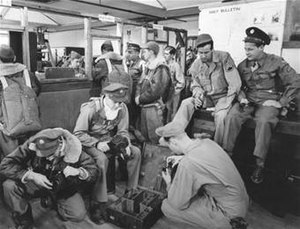
Back Histoire du Nouveau-Mexique pendant la Seconde Guerre mondiale French Novo México durante a Segunda Guerra Mundial Portuguese
| New Mexico during World War II | |
|---|---|
 Enlisted men drawing cameras to go up in a Beechcraft AT-11 on bomb-spotting missions at Roswell Army Flying School. | |
| Population | 531,818 (1940) |
| Date | 1941–1945 |
| Casualties | ~2,349 |
| Events | Lordsburg Killings – July 27, 1942 Escape from Fort Stanton – November 1–3, 1942 Bat Bomb Incident – May 15, 1943 Santa Fe Riot – March 12, 1945 Trinity explosion – July 16, 1945 |
The history of New Mexico during World War II is characterized by dramatic and lasting changes to its economy, society, and politics. The state played a central role in the American war effort, contributing a disproportionately high number of servicemen and natural resources;[1] most famously, it hosted the sites where the world's first nuclear weapon was designed, developed, and tested.[2]
When the United States entered World War II in December 1941, New Mexico had been a state for only three decades and was largely marginal in national affairs. Its sparse population, remoteness, and geography proved ideally suited for top secret military bases and scientific laboratories—most notably at Los Alamos, which undertook the advanced nuclear research that led to the atomic bomb.[3] New Mexico also hosted a variety of military installations, from training facilities to army hospitals, as well as several camps for prisoners of war and Japanese American internees.
New Mexicans were among the first Americans to see combat in the war, with over 1,800 fighting Japan's invasion of the Philippines just hours after its attack on Pearl Harbor. Patriotism ran high throughout the state's diverse and disparate populace, including among its long-marginalized Hispanic and indigenous communities; among them were several of the famed Navajo code talkers, who were critical to protecting U.S. wartime communications. New Mexico would provide more military volunteers, and suffer more casualties, than any other state.
World War II had an immediate and enduring transformative effect on New Mexico. Government investment precipitated an unprecedented economic and demographic boom, with the state's pre-war population of 530,000 nearly doubling to 950,000 by 1960. New Mexico's largely agrarian prewar economy became more industrialized, and its mostly rural population became increasingly urban. Many of the military and scientific installations built during the war remain active and strategically valuable to this day; the wartime development of modern military technology fostered a unique and continuing relationship between New Mexico, the federal government, and the scientific community.[4][5][6]
- ^ "New Mexico and World War II". HISTORY. Retrieved 2022-12-23.
- ^ "World War II and New Mexico". Atomic Heritage Foundation. Retrieved 2022-12-09.
- ^ "Manhattan Project: Establishing Los Alamos, 1942-1943". www.osti.gov. Retrieved 2022-12-09.
- ^ Roberts, Susan A.; Calvin A. Roberts (2006). New Mexico. University of New Mexico Press. ISBN 978-0-8263-4003-0.
- ^ "World War II From a New Mexican Perspective" (PDF). Retrieved November 28, 2012.
- ^ "census.gov" (PDF). Retrieved November 28, 2012.